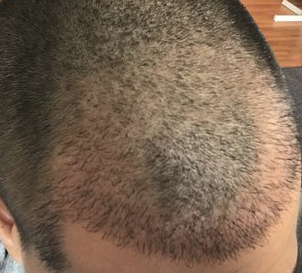This patient had an FUE 5 days earlier. What I want our readers to note, is that there is not only no crusting on the recipient area, but the donor area is completely healed, I get emails frequently which show terrible crusting after a hair transplant in the recipient area. I tell everyone our routine, which I will now repeat here:
I don’t like the idea of anyone removing grafts that have scabs on them because we have published a paper in a formal medical journal, that when a person pulls off a scab (crust) from a recipient area in less than 12 days (possibly longer), the risk of losing the graft is very high. See the medical paper we wrote here: https://baldingblog.com/wp-content/uploads/pdf/mp-2006-graft-anchoring.pdf
In FUE or any transplant including a beard transplant it should be treated just like a regular hair transplant with regard to the recipient area, but if the donor area has open wounds (FUE), it requires daily washing with soap and water. Within 3 days of surgery, you can resume full activities, heavy exercises if you wish. The recipient area requires daily washes as well to keep the recipient area free of crusts. I generally recommend the use of a sponge and supply my patient with a surgical sponge to fill with soapy water and press on the recipient area daily in a rolling motion, never rubbing. By repeating this daily, all crusts can be washed off without any fear of losing grafts. IF any crust are present, use a Q tip and dip it into soapy water, and roll it on the crusts and that will lift them off without dislodging them, but never rub them, just roll the Q tip on the recipient crust. I like to see no evidence of any crusting in the recipient area and the crusts from the donor area gone in 5+ days with daily washing.





